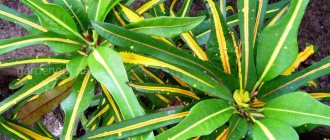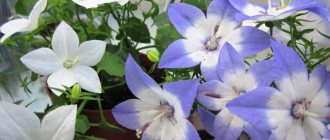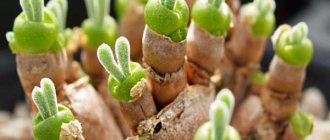Croton is an interesting ornamental plant. Its other name is codiaeum. Many gardeners use both, considering them synonymous, although these are two closely related genera belonging to the same family. The plant has another popular name: Joseph's cloak. It refers to the biblical story of Joseph the Beautiful (son of Jacob).
Photos of varieties of codiaum can be seen in the article at the link, where the most popular and attractive varieties are selected.
Briefly about care
- Watering. Abundant, warm, settled or filtered water. Between waterings, allow the top layer of soil to dry a couple of centimeters deep.
- Lighting. Loves bright diffused light. It is useful to expose the flower to morning or evening sunlight.
- Humidity. Maintain at 70–80%. Place a humidifier or container of water nearby. The plant needs to be sprayed every day.
- Temperature. The tree develops well at 20 ᵒC–26 ᵒC. During rest, you can reduce it to 18 ᵒC. Croton codium begins to react sharply to temperatures below 17 ᵒC.
- Blooms. It produces inflorescences in adulthood. Flowers greatly weaken the plant and do not serve a decorative function, so they are removed.
- Rest period. From November to February the bush slows down its development; at this time it is permissible to slightly reduce the ambient temperature.
- Transfer. They simply do transshipment for young plants a couple of times a year, for adults once every 2-3 years. For trees older than 5–6 years, the soil on top is simply changed.
- The soil. Croton needs porous and nutritious soil. For looseness, add sand, coal, vermiculite or a small amount of sphagnum moss to the soil.
- Fertilizers. From March to October it is necessary to feed 2 times a month with a high-potassium fertilizer. In winter, once a month, or give the roots a rest during this period. Be sure to fertilize on watered soil.
- Reproduction. The shrub is grown from aerial shoots, seeds and two types of cuttings. The most popular and simplest is growing apical cuttings.
- Diseases. Mostly fungal. The manifestation of diseases is provoked by improper home care.
- Pests. They appear rarely and only on weakened plants. Like diseases, they are the result of inappropriate care.
Description of the plant
Croton (codiaum) is a very beautiful indoor plant; it is often used to decorate various interiors. The appearance is similar to a tree or an upright bush.
In native tropical forests it grows to a height of three meters. Cultivated forms reach a maximum of 1.5 meters, often stopping at one. Some varieties have dwarf sizes up to 60 cm high.
The leaf is dense, leathery, in different shades of traffic light colors: red, yellow and green, with a slight glossy sheen and clearly visible veins. Some varieties have very dark foliage, even black.
The color and shape of the spots depends on the age of the plant and lighting.
With proper care and location, young light-colored yellow-green leaves develop patterns and gain color over time. The plates themselves vary: from an elongated narrow-leaved form to a three-fingered one; from straight cut to intricately curved sheet.
Croton's stem is straight and thin compared to its massive foliage. Often the trunk needs strong support so that the plant does not break. Usually the bush branches well, but the side shoots grow slower than the central one. Only some varieties have difficulty sprouting new branches.
The crown forms slowly. For a beautiful and lush appearance, the plant needs to be periodically given a kind of “haircut”. They begin to form a crown at one and a half years old.
The Croton tree belongs to the Euphorbiaceae family and has toxic sap. It can cause diarrhea or vomiting. In case of contact with skin, it can cause both irritation and burns.
The milky sap of croton is poisonous to both animals and humans. It is better to keep Croton out of the reach of children and animals. And when working with the plant, it is advisable to wear gloves and long sleeves. When finished, wash your hands with soap and thoroughly clean all tools.
Changing location is stressful for a picky flower, which is why it is so important to purchase a healthy plant. When purchasing, pay attention to the leaves. They should be bright, elastic, without spots or dry areas. On a healthy tree, the foliage at the top faces upward, and below it is located almost horizontally. The trunk should not have holes - this is the result of falling leaves. Pay attention to the soil: the lump should not be overwatered or dried out.
When buying a moping plant and changing its location, there is a risk of aggravating croton disease, up to the loss of all its decorative properties or the death of the flower.
There are several signs and superstitions associated with croton, and it is not for nothing that it is called the guardian of the home. He is able to cleanse the house of negative energy, and prevents people with bad thoughts and energy vampires from approaching. The flower supports the owners in all endeavors and has a positive effect on emotions. It also helps to cope with diseases of the kidneys, adrenal glands and bladder, and smoothes speech defects. A bad omen is a flowering plant: a kind of warning of danger. It doesn’t have to be serious, but it’s worth paying more attention to business and the surrounding situation.
Indoor plant species and varieties
A single species, Codiaum variegatum, as well as its varieties and hybrid varieties, began to be grown as indoor plants. But they represent such a wealth of shapes and colors that other types were simply not useful.
Varieties of Codiaum variegatum:
- The narrow-leaved croton is equipped with long (about 20 cm) leaves, their width is no more than 1 cm. Yellow-golden strokes and specks are scattered across the green background.
- The appendage-like croton is variegated and green. Its leaves, wide at the base, narrow in the middle into a kind of petiole, and then expand again, forming a small leaf appendage at the end.
- Curly codiaum (crispum) has long, narrow, curled leaves. The greenery has stripes, spots, veins or a network of different shades of yellow. The brightest representative of the variety is Spiral with uniform turns of leaves.
- Lobed croton is distinguished by wide leaves divided into three parts. The central lobe is much longer and wider than the lateral ones. Yellow veins decorate the bright green of the leaf.
- Flat-leaved (platyphyllum) codiaum is a plant with large (up to 30 cm in length and 10 cm in width), oval leaves, their edges are slightly wavy.
- Oval-leaved (ovalifolium) with simple leaf blades in the shape of an elongated oval with a rounded end, rich yellow markings located along the veins.
- The tortoiseshell variety (tortile) is distinguished by leaves that are broad at the petiole and taper towards the tip. On an olive green background there are red and yellow stripes along the central vein and chaotic golden spots.
- Genuinum is a variety with solid oval leaves covered with a pattern of silver or gold color with a reddish tint. There are forms with small and ribbon foliage.
- Codiaeum variegatum pictum is the original form for most hybrid varieties. This is a shrub with a straight stem (up to 1 meter in height), which is covered with dense and hard leaves. They are painted with a pattern of bright yellow, red, pink spots on a green field.
The most famous varieties and hybrids of Codiaum variegatum pictum:
- Croton Petra is a branching stem bearing large, leathery leaves. Yellow veins, edges and dots are drawn on the main green background. The shape of the leaves is varied.
- Mrs. Iceton is a variety with wide, rounded leaves. Young plants have a cream pattern on them. With age, the color becomes more intense, becoming pink, yellow or red. There are forms of blood red or very bright yellow shades.
- The Excelent variety is easily recognized by its leaves, similar in shape to oak leaves. Young leaves, at the top of the plant, are yellow-green. At the base of the trunk - burgundy.
- Coroton Mammi is distinguished by narrow, small leaves. Their edges are slightly curved from the center. The color combines different shades of green, yellow, red and pink.
- The Zanzibar variety has long (about 40 cm) yellow-green leaves. They curve gracefully.
- Nervia is a variety with a colorful crown of bright green, lemon yellow and soft pink leaves. They are jagged with a well-defined vein in the center.
- Croton Tamara is a very rare variety. Oval leaves of medium size, bicolor. On the main dark green background, there are light green and white spots closer to the edges.
- Disraeli is a variety with lobed leaves. They are green-yellow above and red brick-colored below.
- Codium Black Prince with flat and wide foliage. The coloring is very original: the background is dark green, almost black, with red, yellow or orange markings.
What is Croton variegatum mix
Often, specialized stores offer plants called codiaum (or croton) variegatum mix. This is not a variety, but an indication that the batch contains specimens of this variety. Their color depends on the conditions and age of the leaves. So the same plant can look different. And even experts sometimes find it difficult to accurately identify the varietal identity of croton.
The name “Croton variegatum mix” can hide any variety
Video: introduction to crotons (codiaums)
Croton bloom
Croton is a decorative deciduous species, but it also belongs to flowering plants. It blooms rarely, already in adulthood and with proper care of the bush. The raceme inflorescence emerges from the leaf axil (the connection between the petiole and the stem), the arrow contains up to two dozen small yellow-white flowers.
Croton bloom
Flowers can be either male or female. But there is only one view on one arrow. Male ones are round balls studded with stamens, and female ones are curved pistils. During flowering, the plant produces two arrows with different sexes.
Croton flowering is not as spectacular as its leaves, but it takes a lot of nutrients. Flowering also greatly reduces the development of the plant for 3–4 months. Therefore, many gardeners, when an arrow appears, immediately remove it.
Environment
Proper home care of croton is based on “three pillars”: high humidity, optimal temperature and necessary lighting. If the optimal parameters of these categories are observed, croton is almost not capricious.
Humidity
Croton prefers high humidity (70–80%) environments. Codiaum feels good if there is a humidifier or just an open container of water nearby. You can also use a double pot with a layer of wet peat or moss; pour pebbles or moss into the tray, moistening them periodically.
Croton requires daily spraying and weekly leaf wipes. If this is not done, then there is a risk of spider mites infesting the croton. The tree will be grateful for a periodic shower or bath.
The frequency of basic water procedures is determined by the plant, but showers are stopped during the dormant period. Reduce the intensity of watering: the lump should be slightly damp.
The number of spraying and wiping should be reduced during the heating season, if there are no radiators nearby. Otherwise, the plant needs to maintain high humidity and regulate watering.
Temperature
Comfortable temperature for a flower: 20 ᵒC–26 ᵒC. If it is higher, it should be moistened more often. Croton responds well to fresh air: in warm weather it is placed on a loggia or balcony.
Croton has a negative attitude towards drafts and significant temperature changes. In winter, it should not touch a cold window, and watering should only be done with water at room temperature.
The dormant period is expressed by slowing down and stopping the development of the bush, and takes place in the winter season, from November to February. The optimal temperature for this period is 18 ᵒC, and below 17 ᵒC is already dangerous for the plant, it freezes.
Diseases and pests
Improper care of the plant can lead to dire consequences. Codium is susceptible to attack by mite parasites, which is caused by excessively dry air. Symptoms of the disease are the appearance of white spots on the leaves, which begin to fall off over time. A number of actions will help you cope with this parasite:
- increasing the humidity in the room to the required level;
- washing the leaves with water and a specially prepared solution of soap and tobacco;
- treatment of leaves with specialized means (Derris, Fitoverm, Fufan).
Infection with scale insects is also an unpleasant consequence of improper plant care. It manifests itself in the appearance of brownish plaques on the leaves, which begin to dry out and fall off. In this case, wiping with a solution of tobacco, soap and kerosene, rinsing with water, and treating with Actellika will also help to cope.
Proper care of the Codiaum flower will allow you to enjoy its tropical bright leaf colors all year round. And if the living conditions are comfortable for him, he will not cause much trouble in his maintenance.
Watering and wet care
Water for home care is used to use settled or filtered water. It should be warm, slightly warmed up.
During the period of active growth (spring and summer), the plant is watered abundantly. To avoid waterlogging, wait until the top layer dries a couple of centimeters between waterings. In autumn, the frequency of watering is reduced, and in winter the soil is left dry for several days. During this period, the rule applies: the lower the temperature, the less watering.
At any time, the soil should not be allowed to dry out completely: the leaves of the croton droop. If this happens, water the lump well (you can put it in water along with the pot) and spray the leaves. The ground will absorb the required amount of water, and excess water will drain away.
You need to spray the bush at least once a day, twice during dry periods. The above-ground part is bathed in the shower once a month. Croton loves cleanliness: when dust accumulates on the leaves, the plant gets sick. Dirt interferes with air exchange and slows down the process of photosynthesis, and also contributes to the appearance and activity of harmful insects. Therefore, the codiaum must be carefully wiped with a damp cloth once a week.
The more often you spray croton, the fewer problems there are with it.
Signs and superstitions
- It is believed that Codiaum (Croton) is a very energetic flower. Many believe that he does not allow people with negative energy into the house. The flower senses people with bad thoughts and protects people living in the same room from them. Croton affects order and stability in the home.
- It improves the efficiency of its owners who are indecisive, despondent, or pessimistic. Codieum gives self-confidence and removes all negative phenomena. People suffering from speech problems communicate better in a room where the plant is located.
- For people involved in art, the flower is useful for new ideas and plans. It is also good to have a plant in the workplace to harmonize business relations between employees.
Sources
- https://diz-cafe.com/rastenija/kroton-kodieum-uxod-za-priveredlivym-krasavcem-v-domashnix-usloviyax.html
- https://greensotka.ru/dekorativno-listvennye/kodieum-ukhod-v-domashnikh-usloviyakh.html
- https://stroy-podskazka.ru/kroton/kodieum/
- https://stroy-podskazka.ru/komnatnye-cvety/kodieum-petra/
- https://selo.guru/rastenievodstvo/sukkulenty/kroton-kodieum/vidy-kr/petra.html
- https://ogorodnikam.com/komnatnye-rasteniya/kodieum-petra/
- https://mvazonchik.ru/kodieum-petra-uhod-v-domashnih-uslovijah.html
- https://kaktus-sukkulent.ru/drugie-rasteniya/kroton-kodieum-populyarnye-vidy/
[collapse]
Trimming
Before the active growth phase, croton is pruned. With a sharp knife, in one motion for each stem. Each cut is treated with charcoal, several times if necessary. After the procedure, the plant is given time to get used to the new crown, moving it to partial shade and reducing watering.
Croton should not be sprayed immediately after pruning! The cut areas may begin to rot.
The procedure is carried out for two purposes: to form a crown or stimulate growth.
Creating a beautiful crown shape
- It is carried out more often in young plants. Some gardeners ask how to prune croton so that it is fluffy. To form a lush crown in the croton, shoots are periodically pinched, forcing the bush to branch. The first procedure is carried out at approximately one and a half years, when the stem reaches a height of 15 cm. This is done to stimulate the growth of side shoots, since they grow slower than the main stem. After six months, the growth of young shoots is adjusted. Subsequent “pinching” occurs as the stems grow to 20 cm, and this is repeated for all shoots.
Stimulating development in adult shrubs
- Ficus croton needs full pruning at the age of 5 years. At this time, the bush slows down its growth processes, and this procedure is carried out to stimulate its development.
- Haircut or pruning for hygienic purposes: remove dried and diseased stems and leaves. Carry out for plants older than 2–3 years.
Before the shearing or pruning procedure, be sure to remove inflorescences or flower buds so that the plant can safely survive the procedure. Also, do not touch the plant during illness, it may die.
Transplanting a plant
In order not to expose the bush to unnecessary stress, a simple transshipment is usually done in the spring. A lump of earth is touched only in cases of soil acidification, the presence of pests or root rot. To maintain the integrity of the mass, the plant can be watered well before the procedure.
Young bushes up to two years old fall over as they grow, usually once or twice a year. Adults - once every 2-3 years. When plant growth slows down, only the top layer (5–6 cm) of soil is changed. A decrease in development activity occurs closer to 5–6 years, when the diameter of the pot reaches 23–25 cm.
The codiaum plant loves transshipment and will thank you for it with a lush crown. The shrub urgently needs replanting when the roots come out of the water drainage holes.
After purchase, you should not immediately replant the croton; within two weeks it should get used to the new environmental conditions. If this is not done, the plant will get sick. After quarantine-adaptation they act as during normal transshipment. There is no need to change the soil if there are no diseases or pests, you just need to add fresh soil.
When transplanting, observe the following conditions:
- The pot for croton is larger than the diameter of the roots or the previous container by 2–4 cm. It is of medium depth, but the roots must not reach the drainage. The main rule when choosing a pot is that there should not be a lot of free space, otherwise the roots will begin to rot. Young plants can be planted in a plastic container; it will help track the condition of the roots. And for an adult bush, ceramic is preferable: it will serve as a kind of counterweight for heavy roots and absorb salts unnecessary for codiaum.
You need a pot with good drainage holes. Croton loves moisture, but excess water is detrimental to the root system.
- The soil for croton needs to be light, slightly loose and fertile, with the necessary microelements. You can take a ready-made substrate for palm trees or ficus trees, or prepare it yourself. There are many recipes for such compositions. Usually garden soil, peat and sand are mixed in equal proportions. Another simple way: mix universal soil with orchid soil and charcoal. To increase fertile properties, add compost, humus or leaf soil to the mixture. For more airiness, you can use chopped sphagnum moss. For drainage, take expanded clay, small broken bricks or polystyrene foam.
When working with sphagnum moss, it is worth considering that it remains wet for a long time, so it is added to the soil for croton in small quantities and only chopped.
Before use, the pot and soil are disinfected: spilled with boiling water or a solution of potassium permanganate.
Reproduction
Reviews about the flower are diametrically opposed: some write that it is almost impossible to propagate, while others say that croton grew easily and simply. So what is the reason for such different opinions? It's all about choosing the right method and time for reproduction.
Like most plants, there are several ways to propagate croton at home. These are cuttings, layering and seeds. The first two are used from April to June, when the plant has just emerged from the dormant phase and is actively beginning to develop. Seeds are planted in January–February.
Air layering
This propagation of codiaum is more often used due to a disease: when the stem is exposed. Or in adulthood, when there are a lot of woody shoots. In both cases, propagation using air layering is used in two ways.
- The first method is good if the plant has lost its decorative function. Choose a place on the stem at a distance of 10–15 cm from the top, and if necessary, clear it of leaves. The bark in this area is removed in a circular manner. The width of the exposed part should not exceed 1 cm. The cut is treated with a growth stimulator, wrapped in sphagnum moss or peat, and covered with film to maintain moisture. For convenience, you can use a plastic cup instead of film. The roots will appear after a month, but the cuttings are separated when they grow to 5 cm. Small roots are not able to feed large croton leaves well. There is no need to worry about how to root croton: in suitable soil the shoot will take root well. The pot is moved to a shaded place for several weeks. Care and watering as for an adult plant.
- The second method is more suitable for an adult plant, when the stems are mostly woody. The shoot is bent to the ground (you can use a pot or bucket with soil). The bark is also removed from the area closest to the soil and the cut is treated with a growth stimulant. The selected area is secured with wire and moist soil is poured on top. Within a month, leaves will appear from the ground. After they grow up, the cuttings are dug up and transplanted into prepared soil. The pot with the young bush is placed in a bright, shaded place, watered and sprayed abundantly.
To grow croton by air layering, the substrate around the bare trunk must be constantly moist.
Seeds
Dilutions using this method are used to obtain a hybrid plant, since croton, when propagated by seeds, does not retain the properties of the mother tree. The seeds themselves are difficult to obtain at home: each plant has both “male” and “female” flowers, but to get strong seeds, you need to grow two shrubs and cross-pollinate them with each other.
The germination of the resulting seeds is one year; before planting, they must be disinfected using special preparations, or by soaking for half an hour in water at a temperature of 60 ᵒC, and after 1 day kept in water at room temperature. Purchased seeds do not need such a procedure, but they can be kept in water with growth stimulants.
The seeds are planted in loose, fertilized soil to a depth of 1 cm. The container is covered with transparent glass or film. The container with seeds is placed in a bright place, with a temperature of 22 ᵒC–25 ᵒC. It is better to organize watering and heating from below. Seeds need ventilation every day. When seedlings appear, the ventilation time is increased, allowing the shoots to adapt. The leaves begin to appear after a month, and after the third is formed, the sprouts are planted in pots.
During ventilation, it is important to avoid temperature changes and drafts.
Cuttings
The simplest and most commonly used method. You can take cuttings in two ways: using apical or leaf cuttings. They differ only in the selected element for development. In the first, this is the upper part of the stem or shoot, 10–15 cm long. The second type involves the propagation of croton by leaf: they take a part of the stem with at least one leaf and the obligatory presence of an axillary bud.
Croton does not reproduce only with leaves - the leaf will take root, but the stem will not appear.
The apical cutting takes root more easily. But it requires a little preliminary preparation - removing a few bottom sheets.
The following is a diagram of how to propagate croton at home using cuttings:
- The cut areas are washed with water or blotted with a napkin, removing the released juice.
- The lower end of the cutting is lowered into water. Before rooting in water, the cut can be dipped in a stimulating composition. The same water is used as for irrigation. To prevent excessive evaporation of moisture, the cuttings are covered with a transparent bag or film. You can simply cut off the upper leaves in the middle along the veins.
The cutting should not touch either the bottom of the vessel or its walls.
- The container is placed in a place with diffused bright light, at a temperature of 25°C–30°C. At lower temperatures, roots will not appear. In this case, you need to adjust the temperature and update the cut, shortening the cutting by 1–2 cm. If the temperature is higher than optimal, fungi and rot may develop.
- A month later, when the roots reach a length of 2–3 cm (leaf cuttings are 3–5 cm), we root them into the ground.
- The pot with the bush is placed in a place with bright, diffused light. In the first week or two, maintain the same temperature, gradually lowering it, and often moisten the plant and soil. When the leaves regain their elasticity, the plant has completely taken root. The next replanting of the succulent will be required when the roots completely fill the pot.
For the first rooting or picking, it is better to plant them in small pots with a diameter of about 10 cm. If there is no suitable container size, then you can plant several sprouts in one large pot and replant them after six months or a year.
Description of croton, origin, features
There are over 1,000 trees and shrubs in the Croton genus that grow in the tropics. Codiaeums are representatives of the Euphorbiaceae family. Types of croton - 17 varieties. At home you can often find Codiaeum variegatum. Flower growers are accustomed to calling it Croton.
The homeland of Codieum is the tropical forests of Southeast Asia and the islands of Australia. The air temperature in these parts never drops below + 25°C. Precipitation is plentiful but rare, the soil is always moist. In this regard, the plant prefers warm air along with high humidity.
The origin of the name has 2 versions:
- The plant is named after the ancient people who lived in Indonesia on the Moluok Islands.
- Croton is a city located in Italy. It was in honor of him that the scientist Carl Linnaeus named the flower.
Codium variegated contains milky sap, so the plant is considered poisonous. Once in the gastrointestinal tract, the juice of the culture causes diarrhea, vomiting, and skin irritation. Therefore, all planting work, as well as codiaum care at home, must be carried out with gloves, and care should be taken to ensure that children and pets do not approach the crop.
If in natural conditions you can find specimens over 3 m, then at home the height of the codiaum can reach only 1.5 m. The shape of the variegated leathery leaf plate can be:
- ellipsoid with a sharp or rounded end;
- elongated;
- oval;
- wavy;
- spiral.
On one plant you can see different shades of burgundy, purple, red, yellow. In nature you can see croton blooming.
On a note!
The better the conditions of detention, the richer and brighter the colors of the plates will be. With age, the color intensifies.
How does croton bloom at home?
Croton blooms
At home, you can also see croton blooming, but the whitish flowers cannot compete with the painted foliage - they look inconspicuous.
Croton bloom
All crotons differ in appearance. For example, Croton aucubifolia is characterized by green lanceolate foliage. Yellow dots are scattered on the surface, their location is chaotic.
Croton angustifolia is an interesting variety. The foliage is small, pointed, reaching only 1.5 cm in width. In most cases, golden spots are scattered across the surface of the plates.
Croton Mammi is a hybrid variety. It has gained popularity among gardeners due to its unusual foliage shape. The plates are narrow, spiral-shaped. Looking at them, it seems as if the plant is curly. The foliage shows shades of pink, red, and green. If you want to see the Mammy croton bloom, you will need to try and put in a lot of effort.
Cleanliness of leaves
The foliage should not be allowed to be covered with a layer of dust. Because of this, the plant may become sick. Therefore, it is recommended to constantly wet wipe the plates to remove dust and open the pores.
Dirt inhibits photosynthesis, which causes a deficiency of nutrients. In addition, dust is an ideal environment for the development of pathogens and pests.
Dust should be wiped off at least once a week with a soft, damp cloth. To add gloss to aged foliage, wipe the plates with a special aerosol or use folk recipes: wipe with milk or beer.
Florararium and croton
Representatives of the Euphorbiaceae family love high air humidity, so they can be grown in a florarium. This is where you can see how the croton blooms. It is easy to maintain high temperature and humidity in a glass or plastic container.
Planting rules:
- The bottom of the florarium is filled with drainage. You can use small pebbles mixed with charcoal. Add breathable soil and sand.
- Plants with the same requirements for living conditions should be planted in one container.
- After planting the flowers, you will need to water them, cover the florarium with glass and place it in a bright place.
- Until the plants adapt, it is recommended to ventilate the greenhouse daily to remove condensation.
For a mini-jungle, you need to have a shower once a month. If necessary, remove damaged foliage and add substrate as needed.
For croton, good neighbors would be:
- reo;
- fittonia;
- dwarf ficus;
- fern;
- ivy.
Attention!
Cacti and succulents should not be planted in the florarium near lovers of tropical climates.
It should be noted that a florarium such as a sealed container is not suitable for growing codiaum. The fact is that the plant has large leaves, so it cannot grow in a bottle.
Is it possible to grow a bonsai from codiaum?
Only experienced gardeners can grow variegated codiaum in bonsai form. Makes the process difficult:
- heavy and large foliage;
- with minimal errors, the crop quickly resets the plates;
- the trunk is difficult to form;
- the plant does not respond well to transplantation.
Common reasons for changes in appearance
All major problems in home care arise from improper methods and unsuitable environments. Any change in appearance is a signal, and if ignored, the plant will become seriously ill. You need to figure out if there is a problem: yellow spots on croton can be either a reaction to stress, pests or lack of a nutrient medium, or simply a specific feature of it. Almost all changes in appearance can be corrected; the main thing is to prevent the crown from falling off.
Why do the tips of croton leaves dry out and turn brown?
The main reason is insufficient air humidity. Codiaum requires daily spraying. A humidifier or an open container of water should be placed next to the plant. Or simply move it away from the radiator. Sometimes leaf tips signal the appearance of pests. Less commonly, they may indicate low temperatures or insufficient watering.
Why do brown spots appear on the leaf?
The plant was exposed to strong sunlight or the plant was kept at low temperatures for a long time. The plant benefits from only weak rays; at midday the shrub must be shaded. The ambient temperature should not fall below 17 ᵒC.
What does the brown edge on the sheet mean?
The plant is cold, the ambient temperature needs to be adjusted.
Croton has green leaves. This is fine?
This means that the croton flower does not have enough lighting; it needs to be moved to a place with bright, diffused light. Another sign of a lack of light is stretching of the stems. There is a subspecies of codiaum with green leaves and yellow spots that only appear in the right light.
Why don't croton leaves turn red?
There are many varieties of codiaum, and some have different shades of leaves. The color of the foliage appears in diffused bright light.
Spots on the leaves lose color and turn green. What to do?
The soil contains a lot of nitrogen. It is necessary to change the fertilizer, preferably to one with a high potassium content.
The leaves have lost their elasticity. What is the reason?
This happens with excessive watering; you need to adjust the plant’s watering regime.
Has my croton dropped its leaves? What am I doing wrong?
The roots of the bush cannot absorb water. This is the result of one of two cases:
- the lump of earth has dried out, then they saturate it with moisture. If lowering occurs frequently, then you need to adjust the watering mode;
- the flower is cold due to low temperature (below 17 ᵒC) or temperature changes.
Photo
So, you have purchased a croton indoor plant, how to care for a delightful exotic flower at home? Where to begin?











